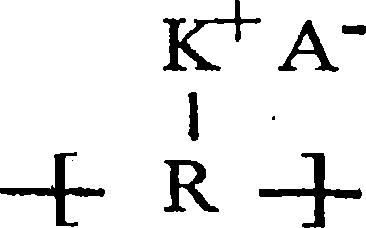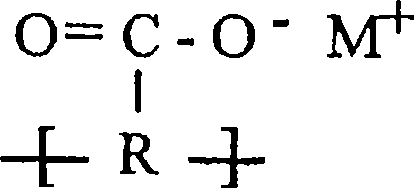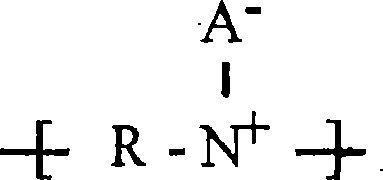Ionic polymer membranes
A technology of ionic polymers and compositions, applied in membrane technology, separation methods, semi-permeable membrane separation, etc., can solve problems such as insufficient inherent efficiency of single distillation
- Summary
- Abstract
- Description
- Claims
- Application Information
AI Technical Summary
Problems solved by technology
Method used
Image
Examples
Embodiment 1
[0089] The examples show the preparation of polymer compositions from copolymers of polyvinylpyrrolidone and polyvinyl acetate (PVP-VAc). The copolymer was purchased from Aldrich Chemical Company, Milwaukee WI 53566 USA (Cat. No. 19,084-5). The average molecular weight (Mw) of the polymer was 50,000 and consisted of 1 / 1 wt / wt vinylpyrrolidone and vinyl acetate (ratio pyrrolidone / acetate molar ratio 1.3 / 1). The polymer was dried in a vacuum oven at 40°C for 16 hours.
[0090] A 2.27 gram portion of dry copolymer and 9.0 grams of methanol were placed in a 20 ml vial. Cap and shake the vial for one hour to obtain a clear solution of copolymer in methanol. Next, 1.0 mL aliquots of the clear solution were added to four 2 mL tared vials. The open vial was placed on a hot plate at 40°C for 18 hours, during which time the methanol solvent was allowed to evaporate slowly. A clear film formed on the bottom of the vial and was identified as PVP-VAc copolymer. The vials were cooled i...
Embodiment 2
[0092] This example measures the non-selective absorption of toluene / isooctane mixtures on polyvinylpyrrolidone and polyvinyl acetate (PVP-VAc) copolymer films prepared according to Example A.
[0093] A 1 / 1 v / v mixture of toluene and isooctane (both HPLC grade from Aldrich) was prepared. To each of the four vials containing the PVP-VAc film prepared in Example A, approximately 0.3 grams of the liquid mixture was added. Reweigh the vial to four decimal places and calculate the net weight of the liquid added. A measured amount of the toluene / iso-octane mixture was added to each of the four vials (average g liquid / g solid 0.357 g / g). Close the vial tightly and shake vigorously for one minute. Allow vials to stand at room temperature for 48 hours. There was no significant change in vial weight indicating less than about 2% evaporation. The refractive indices of the four supernatants were measured and found to average 1.44177 (range of + / - 0.0002) at 21.98°C. Simultaneously, ...
Embodiment 3
[0095] This example demonstrates the preparation of polymer compositions from copolymers of polyvinylpyrrolidone and polyvinyl acetate (PVP-VAc).
[0096] A 3.0 gram portion of dry copolymer and 20 mL of methanol were placed in a 20 mL vial. The mixture was shaken at room temperature for one hour to obtain a clear methanol solution of the copolymer. Next, add 0.84 mL of 70% nitric acid (13.0 mmol HNO 3 ) into a clear solution and the mixture was stirred for two hours using a small magnetic stir bar. An aliquot (2.0 mL) of the solution was added to a tared 10 mL glass vial and the solvent was evaporated under vacuum on a hot plate at approximately 70°C to 80°C for four hours to form a solid ionic polymer. The vial was cooled, then 2 mL of methanol was added to redissolve the solid ionomer. The vial was then placed on a hot plate at approximately 40°C to 50°C overnight (14 hours) to obtain a clear, pale yellow ionomer film at the bottom of the vial, determined as (PVP-VAc) / HN...
PUM
| Property | Measurement | Unit |
|---|---|---|
| weight | aaaaa | aaaaa |
| refractive index | aaaaa | aaaaa |
Abstract
Description
Claims
Application Information
 Login to View More
Login to View More - R&D
- Intellectual Property
- Life Sciences
- Materials
- Tech Scout
- Unparalleled Data Quality
- Higher Quality Content
- 60% Fewer Hallucinations
Browse by: Latest US Patents, China's latest patents, Technical Efficacy Thesaurus, Application Domain, Technology Topic, Popular Technical Reports.
© 2025 PatSnap. All rights reserved.Legal|Privacy policy|Modern Slavery Act Transparency Statement|Sitemap|About US| Contact US: help@patsnap.com



